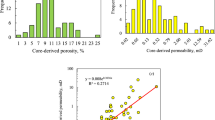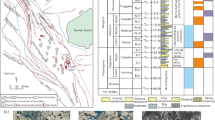Abstract
Tight sandstone reservoir evaluation and characterization faced great challenge by using conventional well logging data due to the complicated pore structure. To improve tight sandstone reservoir identification, the pore structure should be first characterized. In this study, using the tight Chang 8 Formation of Pengyang Region, west Ordos Basin as an example, 20 core samples were drilled for laboratory nuclear magnetic resonance (NMR) and mercury injection capillary pressure (MICP) experiments. A model, which was used to construct capillary pressure (Pc) curves from NMR data, was proposed, and the corresponding models were established based on classified power function (CPF) method to classify formations into three types. Based on these relationships, the NMR T2 distributions were transformed as pseudo Pc curves and pore throat radius distributions. After these relationships were extended into field applications, consecutive pseudo Pc curves were acquired, and the pore structure evaluation parameters and permeability were also predicted. Comparisons of predicted parameters with core-derived results illustrated the reliability of our proposed model and method.











Similar content being viewed by others
References
Coates GR, Xiao LZ, Primmer MG (2000) NMR logging principles and applications: Houston, USA, Gulf Publishing Company, 256 p.
Daigle H, Reece JS, Flemings PB (2020) A modified Swanson method to determine permeability from mercury intrusion data in marine muds. Mar Pet Geol 113:104115
Dunn KJ, Bergman DJ, Latorraca GA (2002) Nuclear magnetic resonance: petrophysical and logging applications: New York, USA, Handbook of Geophysical Exploration, 176 p.
Fournier F, Pellerin M, Villeneuve Q, Teillet T, Hong F, Poli E, Borgomano J, Léonide P, Hairabian A (2018) The equivalent pore aspect ratio as a tool for previous HitporeNext Hit type prediction in carbonate reservoirs. AAPG Bull 102(7):1343–1377
Gao ZY, Hu QH (2018) Pore structure and spontaneous imbibition characteristics of marine and continental shales in China. AAPG Bull 102(10):1041–1061
Ge XM, Fan YR, Cao YC, Xu YJ, Liu X, Chen YG (2014) Reservoir pore structure classification technology of carbonate rock based on NMR T2 spectrum decomposition. Appl Magn Reson 45(2):155–167
Ge XM, Fan YR, Li JT, Zahid MA (2015) Pore structure characterization and classification using multifractal theory-An application in Santanghu basin of western China. J Pet Sci Eng 127:297–304
Ghafoori MR, Roostaeian M, Sajjadian VA (2009) Secondary porosity: a key parameter controlling the hydrocarbon production in heterogeneous carbonate reservoirs (case study). Petrophysics 50(1):67–78
Jia CZ, Zheng M, Zhang YF (2016) Some key issues on the unconventional petroleum systems. Pet Res 1(2):113–122
Krakowskal P (2019) Detailed parametrization of the pore space in tight clastic rocks from Poland based on laboratory measurement results. Acta Geophys 67(6):1765–1776
Li CZ, Wang HH, Wang LG, Kang YM, Hu KL, Zhu YS (2020a) Characteristics of tight oil sandstone reservoirs: a case study from the Upper Triassic Chang 7 Member in Zhenyuan area, Ordos Basin, China. Arab J Geosci 13:78
Li YL, Zhang YF, Fu H, Yan Q (2020b) Detailed characterization of micronano pore structure of tight sandstone reservoir space in three-dimensional space: a case study of the Gao 3 and Gao 4 members of Gaotaizi reservoir in the Qijia area of the Songliao basin. Arab J Geosci 13:119
Lis-Sledziona A (2019) Petrophysical rock typing and permeability prediction in tight sandstone reservoir. Acta Geophys 67(6):1895–1911
Liu GF, Bai YX, Gu DH, Lu Y, Yang DY (2019) Determination of static and dynamic characteristics of microscopic pore-throat structure in a tight oil-bearing sandstone formation. AAPG Bull 102(9):1867–1892
Looyestijn WJ (2001) Distinguishing fluid properties and producibility from NMR logs. Proceedings of the 6th Nordic Symposium on Petrophysics, Trondheim, Norway, May 15-16, 2001, 9 p
Newberry BM, Grace LM, Stief D (1996) Analysis of carbonate dual porosity systems from borehole electrical images: Permian Basin Oil and Gas Recovery Conference, Midland, Texas, USA, March 27-29, 1996, SPE-35158-MS, 7 p., doi: https://doi.org/10.2118/35158-MS.
Olubunmi A, Chike N (2011) Capillary pressure curves from nuclear magnetic resonance log data in a deepwater turbidite Nigeria field-a comparison to saturation models from scale drainage capillary pressure curves. Nigeria Annual International Conference and Exhibition, Abuja, Nigeria, July 30-August 3, 2011, SPE-150749
Ouzzane J, Okuyiga M, Gomaa N (2006) Application of NMR T2 relaxation to drainage capillary pressure in vuggy carbonate reservoirs: SPE Annual Technical Conference and Exhibition, San Antonio, Texas, USA, September 24-27, 2006, SPE-101897
Purcell WR (1949) Capillary pressures-their measurement using mercury and the calculation of permeability thereform. Trans. AIME 186: 39-48
Puskarczyk E, Krakowska P, Jędrychowski M, Habrat M, Madejski P (2018) A novel approach to the quantitative interpretation of petrophysical parameters using nano-CT: example of Paleozoic carbonates. Acta Geophys 66(6):1453–1461
Volokitin Y, Looyestijn WJ, Slijkerman WFJ, Hofman JP (2001) A practical approach to obtain primary drainage capillary pressure curves from NMR core and log data. Petrophysics 42(4):334–343
Xiao L, Mao ZQ, Shi YJ, Guo HP (2011) Analysis of “lower limit formation” in low permeability sands of Ordos Basin. SPE-139782
Xiao L, Mao ZQ, Wang ZN, Jin Y (2012) Application of NMR logs in tight gas reservoirs for formation evaluation: a case study of Sichuan basin in China. J Pet Sci Eng 81:182–195
Xiao L, Liu XP, Zou CC, Hu XX, Mao ZQ, Shi YJ, Guo HP, Li GR (2014) Comparative study of models for predicting permeability from nuclear magnetic resonance (NMR) logs in two Chinese tight sandstone reservoirs. Acta Geophys 62(1):116–141
Xiao L, Mao ZQ, Zou CC, Jin Y, Zhu JC (2016a) A new methodology of constructing pseudo capillary pressure (Pc) curves from nuclear magnetic resonance (NMR) logs. J Pet Sci Eng 147:154–167
Xiao L, Zou CC, Mao ZQ, Jin Y, Zhu JC (2016b) A new technique to synthetize capillary pressure (Pc) curves using NMR Logs in tight gas sandstone reservoirs. J Pet Sci Eng 145:493–501
Xiao L, Liu D, Wang H, Li JR, Lu J, Zou CC (2017) The applicability analysis of models for permeability prediction using mercury injection capillary pressure (MICP) data. J Pet Sci Eng 156:589–593
Xiao L, Li JR, Mao ZQ, Yu HY (2020) A method to evaluate pore structures of fractured tight sandstone reservoirs using borehole electrical image logging. AAPG Bull 104(1):205–226
Zahid MA, Chunmei D, Golab AN, Lin CY, Zhang XG, Ge XM, Wu ST, Munawar MJ, Ma CF, Knuefing L (2019) Pore size distribution and reservoir characterization: evaluation for the Eocene beach-bar sequence, Dongying Depression, China. Arab J Geosci 12:660
Zhang H, Zhu YS, Ma NY, Zhou CF, Dang YC, Shao F, Jiao J, Li L, Wang HL, Li M (2019) Combined technology of PCP and nano-CT quantitative characterization of dense oil reservoir pore throat characteristics. Arab J Geosci 12:534
Zhu XJ, Cai JG, Liu Q, Li Z, Zhang XJ (2019) Thresholds of petroleum content and pore diameter for petroleum mobility in shale. AAPG Bull 103(3):605–617
Zou CN, Zhang RK, Liu KY, Su L, Bai B, Zhang X, Yuan XJ, Wang JH (2012) Tight gas sandstone reservoirs in China: characteristics and recognition criteria. J Pet Sci Eng 88-89:82–91
Funding
This research was financially supported by the Major National Science and Technology Projects (2016ZX05050).
Author information
Authors and Affiliations
Corresponding author
Additional information
Responsible Editor: Santanu Banerjee
Rights and permissions
About this article
Cite this article
Zhang, H., Li, G., Guo, H. et al. Applications of nuclear magnetic resonance (NMR) logging in tight sandstone reservoir pore structure characterization. Arab J Geosci 13, 572 (2020). https://doi.org/10.1007/s12517-020-05590-6
Received:
Accepted:
Published:
DOI: https://doi.org/10.1007/s12517-020-05590-6




